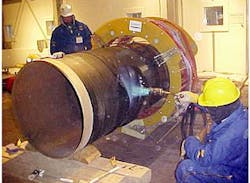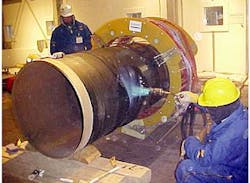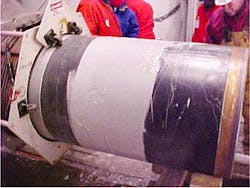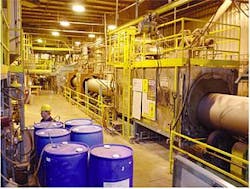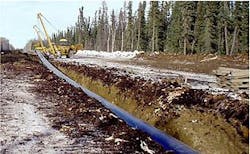Two girth-weld coating systems have been tested successfully by TransCanada PipeLines Ltd. for use in arctic construction and operating conditions.
A multilayer system of fusion-bonded epoxy (FBE) overcoated with polyethylene was selected for the mainline of a construction project in northern Alberta to test proposed construction materials and practices. Coating of the girth-weld area is critical to overall coating performance.
A multilayer liquid coating system and an epoxy primer-based, hot melt, shrink-sleeve system were tested and used for coating the welds. Preliminary full-scale application trials at.2.48° C. validated the proposed field application procedures.
Mainline project
A pipeline to move arctic gas to southern markets requires a coating system able to withstand the rigors of northern construction and operations. And because TransCanada needed to assess the coating options available for a new pipeline from the north, a field trial using Shaw Pipe Protection Ltd.'s High Performance Composite Coating (HPCC) was planned for northern Alberta as part of a routine system expansion project.
The mainline coating selected for the trial was a multilayer system consisting of a minimum 6-mil FBE layer overlaid with 5 mils of a copolymer adhesive and a further 19 mils of fused medium-density polyethylene. This created a total minimum thickness of 30 mils.
Compared to standard FBE, this new system should provide increased flexibility in cold weather due to the reduced thickness of FBE, and the polyethylene layer should provide better resistance to handling and construction damage.
Reduced cathodic-protection requirements were also anticipated, due to a reduced holiday count in operation.
null
The two girth-weld systems were used on this project to evaluate competing technologies and to maintain flexibility in supply of materials and assure availability of contractors for future construction.
System one: three-layer shrink sleeve
The primary girth-weld coating for this project was the CANUSA GTS-65 hot melt sleeve. For this system, the weld area was abrasively cleaned to a near-white finish and solvent washed. An induction coil preheated the area to 100° C. Denso 7250 liquid epoxy and CANUSA High Build Epoxy primers were applied between 50° C. and 75° C. to a minimum thickness of 12 mils.
The liquid epoxy primer provides an adequate corrosion barrier in the unlikely event that the sleeve should fail and allow water ingress beneath the sleeve. The sleeve provides mechanical and moisture protection to the epoxy corrosion barrier.
After epoxy application, induction heating was again used to post-cure the epoxy and preheat the weld area and sleeve overlap to 100° C.
The weld was then wrapped with the sleeve and shrunk with torches. Any entrapped air was rolled out to get full conformation to girth and long-seam welds (Fig. 1).
System two: full-liquid system
A fully liquid-coating system was used on 10% of the project. Denso 7250 liquid epoxy was used as a standalone corrosion barrier, as before, but it was over-coated with SteelGuard 100 polyurea elastomer to a combined thickness of 40 mils (Fig. 2).
Similarly for this system, the weld area was abrasively cleaned to a near-white finish and solvent washed. No further heating or preparation was performed, however, prior to application of the overcoat. Residual heat in the pipe completes curing of both liquid layers.
System Two, a full-liquid process, uses less labor and equipment (Fig. 2).
The advantage of this system is the reduction in required labor and equipment. The overcoat in this case provides additional mechanical and moisture protection to the epoxy corrosion barrier.
Application simulation
A full-scale application trial in the cold weather chamber at C-FER Technologies Inc.'s laboratory in Edmonton validated the feasibility of these two girth-weld coating systems prior to start of construction.
Two joints of 36-in. HPCC-coated pipe were prepared with five simulated weld cutback areas. These areas were blast cleaned to a near-white surface finish, and the pipes were chilled to a temperature of –47° C. in the cold chamber.
Each of the weld-coating systems was applied in turn at –47° C. and evaluated for the ease at which it could be applied under arctic conditions and the properties of the finished product.
Results
The application process worked well. The epoxy primer could be easily applied as long as the preheating was within specification. The sleeve remained sufficiently flexible because it was stored in a heated environment.
Sufficient heat remained in the pipe to allow rolling of the sleeve to remove any trapped air pockets. Excellent adhesion was found to both the epoxy and parent coating.
Brush-grade materials were used in a full-liquid system trial. The epoxy primer was applied with no problems; however, there was a difficult balance to reach with the outer layer application.
If the substrate were too hot, the outer coat would lose viscosity and run off the pipe. If the substrate were too cool, the outer layer would freeze before curing.
The solution was to use a spray-grade material with a shorter pot life for the outer coat. This would ensure the material fully cured prior to freezing.
The epoxy and polyurea formed an inseparable bond; however, the polyurea bond to the parent coating was variable.
An acceptable solution was to test the polyethylene with various levels of flame oxidation.
Field construction
Shaw Pipe Protection Ltd.'s Camrose, Alta., plant coated 3 km of 36-in. pipe with HPCC (Fig. 3). For the most part, the process worked smoothly, and the plant quality tests gave excellent results. There were zero holidays in the coating at the plant prior to shipping.
Very little handling damage appeared from the unloading and stringing process. No damage to the coating resulted from bending.
One advantage of using a coating such as HPCC for arctic construction is the ability to bend the pipe at lower temperatures than an equivalent FBE-coated pipe. This is because the thinner FBE layer (6 mils) in the HPCC gives the coating system more flexibility in cold weather.
FBE flexibility is controlled by thickness. The thinner the FBE, the greater the flexibility, but the lower the impact resistance. HPCC retains its impact resistance with a thin FBE layer due to the outer layer of polyethylene.
On this job, the HPCC-coated pipe was successfully bent at temperatures as low as –45° C. without damaging the coating.
Welding issues, holidays
The main concern from the welding process was the melting of the HPCC polyethylene layer due to the welding preheating. This caused flow of the polyethylene underneath the welding band support legs (Fig. 4). This material had to be dressed off, thus increasing the amount of coating materials required to cover the weld-affected region.
Both weld-coating systems performed well in actual winter conditions and were able to achieve production rates of up to 60 joints/day. Productivity in this trial was limited by the equipment available and crew sizes, but there should be no issues in keeping up with the welding process on a larger spread.
null
null
The average number of holidays requiring repair on an FBE-coated pipeline is about 5-10/pipe joint. On this HPCC trial, the number of holidays per pipe joint was 0.1, or 50 to 100 times less than with FBE.
Of these HPCC holidays, 50% were damage caused by positioning of the welding shacks on the pipe, 25% were weld-band damage not being completely covered, 15% were slivers, and 10% were other contact damage.
It is clear that 75% of the coating holidays could be eliminated with additional care in padding and positioning the welding shacks, as well as ensuring the weld-band damage is properly repaired. This would result in an unprecedented level of coating quality and an extremely reduced level of cathodic-protection current needed to ensure the integrity of the pipeline in the future.
The HPCC pipe loop was designed with isolating unions at each end to allow measurement of the cathodic protection requirement of the pipeline.
Both girthweld systems were applied successfully with adequate productivity and exhibited good properties for cold weather application. The mainline coating system (HPCC) was suitable for extreme cold weather bending (Fig. 4).
Uniform preheat is a key factor in obtaining a quality girthweld coating system application, and welding equipment must be chosen carefully to minimize the damage sustained to the mainline coating system due to preheat.
Acknowledgments
The authors thank Shaw Pipe Protection CANUSA, Denso Canada, Advance Coating Systems, C-FER, KTA–Tator Canada, and Louisbourg Construction Services for their assistance in making this project possible.
Based on a presentation to the 4th International Pipeline Conference (ASME), Oct. 4-8, 2004, Calgary.
The authors
Bob Worthingham is a senior corrosion engineer with TransCanada PipeLines Ltd., Calgary. He has 23 years' experience in cathodic protection, coatings, pipeline integrity planning, and research and development. Worthingham holds a BS in metallurgical engineering from the University of Alberta and is a registered professional engineer in Alberta.
Matt Cetiner is a senior engineer with TransCanada PipeLines Ltd., Calgary, responsible for leading the cathodic protection team. He holds a BS in metallurgy and an MS in corrosion science from the University of Manchester Institute of Science & Technology, England. Cetiner is a registered professional engineer in Alberta.
Meera Kothari has worked for TransCanada PipeLines Ltd., Calgary, for 3 years developing maintenance programs, providing operational technical support, and managing various integrity-related research and development programs. She holds a BS in engineering from the University of Calgary.
